Orange Blue Fine Jagged Non Banded Metamorphic Rock Rock
Home » Rocks » Metamorphic Rocks » Quartzite
Quartzite
The metamorphic rock composed almost entirely of quartz.
Article by: , PhD, RPG
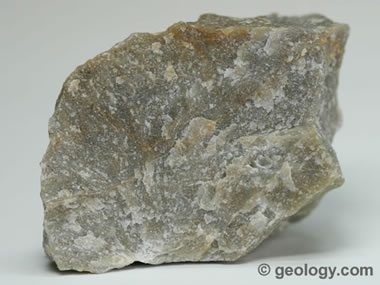
Quartzite: A specimen of quartzite showing its conchoidal-like fracture and granular texture. The specimen shown is about two inches (five centimeters) across.
What is Quartzite?
Quartzite is a nonfoliated metamorphic rock composed almost entirely of quartz. It forms when a quartz-rich sandstone is altered by the heat, pressure, and chemical activity of metamorphism.
Metamorphism recrystallizes the sand grains and the silica cement that binds them together. The result is a network of interlocking quartz grains of incredible strength.
Table of Contents
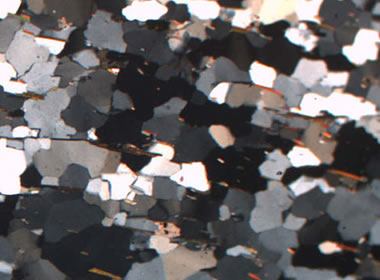
Quartzite Under a Microscope: A specimen of the Bo Quartzite collected near South Troms, Norway, observed through a microscope in thin-section under cross-polarized light. The quartz grains in this view range in color from white to gray to black depending upon their optical orientation. The important thing to notice is how they fit together in a tight interlocking network. The interlocking nature of the grains gives quartzite its incredible durability. Photograph by Jackdann88, used here under a Creative Commons license.
Physical Properties of Quartzite
The interlocking crystalline structure of quartzite makes it a hard, tough, durable rock. It is so tough that it breaks through the quartz grains rather than breaking along the boundaries between them. This is a characteristic that separates true quartzite from sandstone.
Quartzite is usually white to gray in color. Some rock units that are stained by iron can be pink, red, or purple. Other impurities can cause quartzite to be yellow, orange, brown, green, or blue.
The quartz content of quartzite gives it a hardness of about seven on the Mohs Hardness Scale. Its extreme toughness made it a favorite rock for use as an impact tool by early people.
Its conchoidal fracture allowed it to be shaped into large cutting tools such as ax heads and scrapers. Its coarse texture made it less suitable for producing tools with fine edges such as knife blades and projectile points. Obsidian, flint and agate were better suited for tools where sharpness was important.
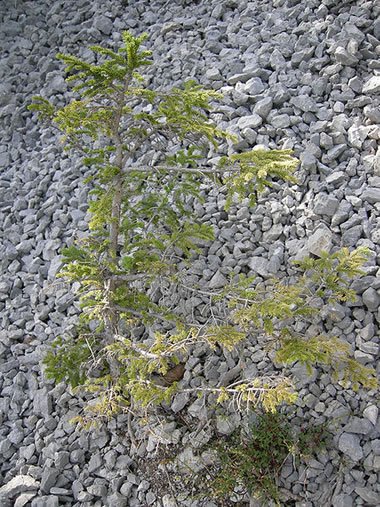
Quartzite scree: A steep slope covered with an unstable blanket of quartzite scree. Scree is a name used for resistant pieces of broken rock that cover a talus slope. This photo was taken near Begunje na Gorenjskem, Slovenia. A Creative Commons image by Pinky sl.
Where Does Quartzite Form?
Most quartzite forms during mountain-building events at convergent plate boundaries where sandstone was deposited on a continental plate. There, the sandstone is metamorphosed into quartzite by the intense pressure of a plate collision and often by deep burial.
Compressional forces at the plate boundary fold and fault the rocks and thicken the crust into a mountain range. Quartzite is an important rock type in folded mountain ranges throughout the world.
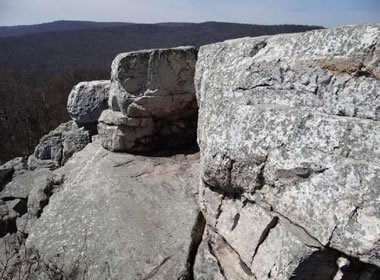
Ridge-Forming Quartzite: An outcrop of the Chimney Rock Formation in Catoctin Mountain Park near Thurmont, Maryland. Catoctin Mountain is part of the Blue Ridge Mountains. The Chimney Rock Formation in this area caps many of the ridges, drapes the flanks of the mountains as scree, and is made up mostly of quartzite. Photo by Alex Demas, United States Geological Survey.
Quartzite as a Ridge-Former
Quartzite is one of the most physically durable and chemically resistant rocks found at Earth's surface. When mountain ranges are worn down by weathering and erosion, less-resistant and less-durable rocks are destroyed, but the quartzite remains. This is why quartzite is so often the rock found at the crests of mountain ranges and covering their flanks as large boulders, or as a surface litter of scree.
Quartzite is also a poor soil-former. Unlike feldspars which break down to form clay minerals, the weathering debris of quartzite is quartz. It is therefore not a rock type that contributes well to soil formation. For that reason it is often found as exposed bedrock with little or no soil cover.
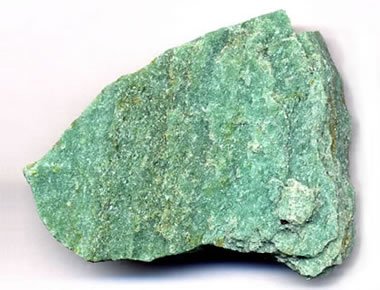
Fuchsitic Quartzite: A specimen of quartzite that contains significant amounts of green fuchsite, a chromium-rich muscovite mica. This specimen measures about 7 centimeters across and was collected from a small abandoned quarry where the flaggy rocks were produced and cut for use as decorative stones. The quarry is in the Elmers Rock Greenstone Belt, Wyoming. Photograph by James St. John, used here under a Creative Commons license.
How the Name "Quartzite" Is Used
Geologists have used the name "quartzite" in a few different ways, each with a slightly different meaning. Today most geologists who use the word "quartzite" are referring to rocks that they believe are metamorphic and composed almost entirely of quartz.
A few geologists use the word "quartzite" for sedimentary rocks that have an exceptionally high quartz content. This usage is falling out of favor but remains in older textbooks and other older publications. The name "quartz arenite" is a more appropriate and less confusing name for these rocks.
It is often difficult or impossible to differentiate quartz arenite from quartzite. The transition of sandstone into quartzite is a gradual process.
A single rock unit such as the Tuscarora Sandstone of the central Appalachians might fully fit the definition of quartzite in the parts of its extent where its quartz grains have been metamorphosed into a durable interlocking mass. It would be better called "sandstone" in other areas.
Between these areas, the names "quartzite" and "sandstone" are used inconsistently and often guided by habit. It is often called "quartzite" when rock units above and below it are clearly sedimentary. This contributes to the inconsistency in the ways that geologists use the word "quartzite."
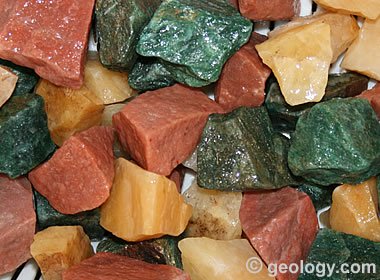
"Aventurine": Pieces of green, yellow, and reddish orange "aventurine" from India. These pieces of rough average about 1 inch across and were sold for making tumbled stones in a rock tumbler. Much of the "aventurine" sold for lapidary use is actually quartzite. Often it exhibits no aventurescence.
Hammer With Caution !
Wise geologists, who have memorable experiences with quartzites, hit them with a rock hammer only when necessary. If a freshly broken piece is needed for examination, they break off a small protrusion with a light tap. That small piece is usually more than enough.
Avoid hitting quartzite with a forceful blow of a rock hammer. It's not a good idea. If you must use your hammer on quartzite, be sure that you are wearing impact-resistant goggles, gloves, long sleeves, long pants, and sturdy shoes.
A sharp hammer blow often bounces off. That bounce can cause injury. So, hit the rock at an angle at which a bounce will not send the head of the rock hammer into your shin.
Instead of bending over to strike the rock, it is often better to get down on one knee and strike the rock with a downward motion. Then, when the rock breaks, the hammer and most of the broken pieces of rock will fly down and hit the ground.
Be certain that nearby field partners are warned and safely away. Hold the base of your goggles with your free hand before striking the rock. That will protect the lower half of your face from sparks and sharp flakes of high velocity rock. You have been warned.
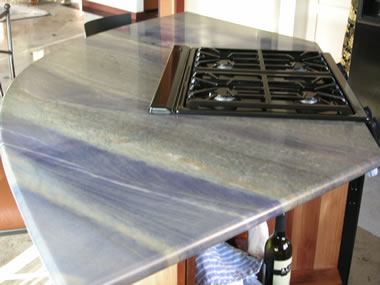
Quartzite Countertop: A kitchen island countertop made of quartzite. In the dimension stone industry, some quartzite is sold as "granite" because in that industry, any hard silicate rock is often called "granite." Image copyright iStockphoto / Theanthrope.
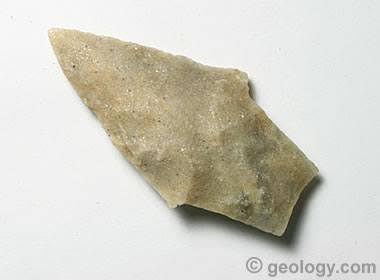
Quartzite arrowhead: Quartzite was often used as a tool by early people. It is durable enough for use as impact tools such as hammerstones. It breaks with a conchoidal fracture, which made it useful for tools with sharp edges, such as hoes, axes, and scrapers. Although it is very difficult to knap, some ancient people were able to knap it into knife blades and projectile points. The photo shows a quartzite arrowhead found in Alabama. If the arrowhead is turned under a bright light, the grains in the quartzite produce a sparkling luster.
Uses of Quartzite
Quartzite has a diversity of uses in construction, manufacturing, architecture, and decorative arts. Although its properties are superior to many currently used materials, its consumption has always been low for various reasons. The uses of quartzite and some reasons that it is avoided are summarized below.
Architectural Use
In architecture, marble and granite have been the favorite materials for thousands of years. Quartzite, with a Mohs hardness of seven along with greater toughness, is superior to both in many uses.
It stands up better to abrasion in stair treads, floor tiles, and countertops. It is more resistant to most chemicals and environmental conditions. It is available in a range of neutral colors that many people enjoy. The use of quartzite in these uses is growing slowly as more people learn about it.
There are also man-made materials marketed under the name quartzite. They can be attractive and durable with a cost comparable to natural materials. Read the marketing materials prepared by the manufacturer.
Construction Use
Quartzite can be an extremely durable crushed stone that is suitable for use in the most demanding applications. Its soundness and abrasion resistance are superior to most other materials.
Unfortunately, the same durability that makes quartzite a superior construction material also limits its use. Its hardness and toughness cause heavy wear on crushers, screens, truck beds, cutting tools, loaders, tires, tracks, drill bits, and other equipment. As a result, the use of quartzite is mainly limited to geographic areas where other aggregates are not available.
Manufacturing Use
Quartzite is valued as a raw material because of its high silica content. A few unusual deposits have a silica content of over 98%. These are mined and used to manufacture glass, ferrosilicon, manganese ferrosilicon, silicon metal, silicon carbide, and other materials.
Decorative and Gemological Use
Quartzite can be a very attractive stone when it is colored by inclusions. Inclusions of fuchsite (a green chromium-rich variety of muscovite mica) can give quartzite a pleasing green color. If the quartzite is semitransparent to translucent, the flat flakes of mica can reflect light to produce a glittering luster known as aventurescence.
Material that displays this property is known as "aventurine," a popular material used to produce beads, cabochons, tumbled stones, and small ornaments. Aventurine can be pink or red when stained with iron. Included dumortierite produces a blue color. Other inclusions produce white, gray, orange, or yellow aventurine.
Stone Tools
Quartzite has been used by humans to make stone tools for over one million years. It was mainly used for impact tools, but its conchoidal fracture allowed it to be broken to form sharp edges. Broken pieces of quartzite were used for crude cutting and chopping tools.
Quartzite was not the preferred material for producing cutting tools such as knife blades and projectile points - but it has been used. Flint, chert, jasper, agate, and obsidian all can be knapped to produce fine cutting edges, which are difficult to produce when working quartzite. Quartzite was most frequently used when it was locally abundant and superior materials were rare or not available.
Find Other Topics on Geology.com:
 Rocks: Galleries of igneous, sedimentary and metamorphic rock photos with descriptions. |  Minerals: Information about ore minerals, gem materials and rock-forming minerals. |
 Volcanoes: Articles about volcanoes, volcanic hazards and eruptions past and present. |  Gemstones: Colorful images and articles about diamonds and colored stones. |
 General Geology: Articles about geysers, maars, deltas, rifts, salt domes, water, and much more! |  Geology Store: Hammers, field bags, hand lenses, maps, books, hardness picks, gold pans. |
 |  Diamonds: Learn about the properties of diamond, its many uses, and diamond discoveries. |
Source: https://geology.com/rocks/quartzite.shtml
0 Response to "Orange Blue Fine Jagged Non Banded Metamorphic Rock Rock"
Post a Comment